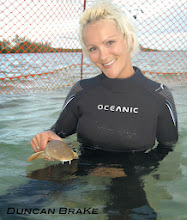2013 has certainly become the year of the great hammerhead shark, especially on the tiny island of South Bimini in the Bahamas. For nearly a decade the Bimini Biological Field Station (Sharklab)
and its staff have been developing sites to dive with and tag these amazing creatures. From January through March, the great hammerheads frequent these crystal clear waters and can be n close proximity to the coastline. Until this year, this aggregation had managed, for the most part, to stay off the radar. This created an ideal research and diving venue, uninfluenced by outside factors. This has all changed this year and the, "cat is out of the bag," so to speak with everyone and their uncle motoring to the shores of Bimini to have their moment in the world’s newest shark diving Mecca.
The shark diving community is small and the Internet has made the world even smaller, so in a short period of time news has spread to the far reaches of the globe in the form of images, social media posts, videos and blogs. Sadly, it has also not taken much time for bickering among boats, claims of discovery and touching/grabbing of the sharks to happen. No one owns these sharks, but the sharks, the scientists who study them and the island they are swimming around, should all be respected. I have shared two letters in a previous post about hammerhead shark diving protocols and encourage people to read them. The world deserves to see these animals and the more positive press and education that is spread, the better their chances of survival.
My first hammerhead encounter happened in 2007 off the coast of Key West, Florida. Since then I have only had a handful of encounters both diving and tagging these animals, but they have remained my favorite animal on the planet without question. The conservation media company my husband and I run has a hammerhead in the logo, we each have hammerhead tattoos that we got before we ever met and our wedding rings have 2 hammerheads engraved on them; we love these sharks.

The crystal clear water of Bimini and the shallow depth, make this an ideal place for photo and video; probably the biggest draw for the masses now flocking to Bimini. The sharks cruise in from the haze and circle around the bait. These charismatic predators are bold, but not aggressive or fearful. They have comical faces, with their mouth on the underside and large cartoon like eyes. They appear to be laughing at a joke or smiling for the camera. Power and grace, with a Cheshire cat smile. No, they do not have the characteristic sleek body or head sharks are known for, but even people who do not know much about sharks can identify a hammerhead.


Sadly, the rare and elusive nature of these creatures, which has catalyzed a global interest in photographing and filming them, is also the reason why research to better understand them is absolutely critical.
I feel truly blessed to have spent so much time with these magnificent animals and I hope that each and every person that slips beneath the surface around Bimini realizes how fortunate they are as well. It is not about getting the shot or filming in 4K; it is about sharing with the world why these animals need protection. Each image, each video clip, each blog, each story shared with friends, is so much more than just those things; it is an opportunity to spread awareness, educate the world and help make sure future generations can know the indescribable beauty of having a great hammerhead swim past.


Hello..your bands are beautiful. What jeweler did you use?
ReplyDelete